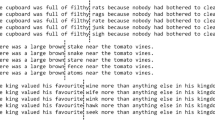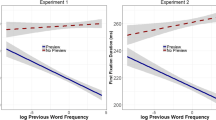Summary
Eye movements were recorded during sentence reading to examine the integration of parafoveal text across fixations. Four viewing conditions were used, each affording full view of the directly fixated word: no preview of the spatially adjacent parafoveal word; preview of its beginning trigram; preview of its beginning four letters; or preview of all its constituent letters. The magnitude of parafoveal-preview benefits (the difference between the no-preview condition and the different parafoveal-preview conditions) was examined as a function of the size of the saccade to the parafoveal target and as a function of the subsequent fixation location at the previewed target. The results revealed no effects of saccade size on parafoveal-preview benefits, but large effects of fixation position during the initial target fixation. Furthermore, parafoveal previews were used during the initial target fixation and during subsequent intratarget refixations. The results support a lexical-text-integration hypothesis which posits that lexical information is integrated across interword fixations and intraword refixations.
Similar content being viewed by others
References
Balota, D. A., Pollatsek, A., & Rayner, K. (1985). The interaction of contextual constraints and parafoveal visual information in reading.Cognitive Psychology, 17, 364 - 390.
Blanchard, H. E., Pollatsek, A., & Rayner, K. (1989). The acquisition of parafoveal word information in reading.Perception & Psychophysics, 46, 85–94.
Hyona, J., Niemi, P., & Underwood, G. (1989). Reading long words embedded in sentences: Informativeness of world halves affects eye movements.Journal of Experimental Psychology: Human Perception and Performance, 15, 142–151.
Inhoff, A. W. (1984). Two stages of word processing during eye fixation in the reading of prose.Journal of Verbal Learning and Verbal Behavior, 23, 612 - 624.
Inhoff, A. W. (1989a). Parafoveal processing of words and saccade computation during eye fixations in reading.Journal of Experimental Psychology: Human Perception and Performance, 15, 544 - 555.
Inhoff, A. W. (1989b). Lexical access during eye fixations in reading: Are word access codes used to integrate lexical information across interword fixations?Journal of Memory and Language, 28, 444 - 461.
Inhoff, A. W. (1990). Integration to text across interword fixations in reading.Acta Psychologica, 73, 281- 297.
Inhoff, A. W., Pollatsek, A., Posner, M. I., & Rayner, K. (1989). Covert attention and eye movements during reading.Quarterly Journal of Experimental Psychology, 41A, 63 - 89.
Inhoff, A. W., Rayner, K. (1986). Parafoveal word processing during eye fixations in reading: Effects of word frequency.Perception & Psychophysics, 40, 431 - 440.
Lima, S. D. (1987). Morphological analysis in sentence reading.Journal of Memory and Language, 26, 84 - 99.
Lima, S. D., & Inhoff, A. W. (1985). Lexical access during eye fixations in reading: Effects of word initial letter sequence.Journal of Experimental Psychology: Human Perception and Performance, 13, 272–285.
McClelland, J. L., O'Regan, J. K. (1981). Expectations increase the benefit derived from parafoveal visual information in reading words aloud.Journal of Experimental Psychology: Human Perception and Performance, 7, 634–644.
McClelland, J. L., & Rumelhart, D. E. (1981). An interactive activation model of context effects in letter perception: Part 1. An account of basic findings.Psychological Review, 88, 375 - 407.
McConkie, G. W., Kerr, P. W., Redix, M. D., Zola, D., & Jacobs, A. M. (1989). Eye movement control during reading: II. Frequency of refixating a word.Perception & Psychophysics, 46, 245 - 253.
McConkie, G. W., & Rayner, K. (1975). The span of the effective stimulus during a fixation in reading.Perception & Psychophysics, 17, 578 - 586.
McConkie, G. W., & Zola, D. (1979). Is visual information integrated across successive fixations in reading?Perception & Psychophysics, 25, 221 - 224.
O'Regan, J. K. (1979). Eye guidance in reading: Evidence for the linguistic control hypothesis.Perception & Psychophysics, 25, 501 - 509.
O'Regan, J. K. (1983). Elementary perception and eye movement control processes in reading. In K.Rayner (Ed.),Eye movements in reading: Perceptual and language processes (pp. 121 - 138). New York: Academic Press.
O'Regan, J. K., & Levi-Schoen, A. (1987). Eye movement strategy and tactics in word recognition and reading. In M.Coltheart (Ed.),Attention and performance (Vol. XII, pp. 353 - 382). Hillsdale, NJ: Lawrence Erlbaum Associates.
O'Regan, J. K., Levy-Schoen, A., Pynte, J., & Brugaillere, B. (1984). Convenient fixation location within isolated words of different length and structure.Journal of Experimental Psychology: Human Perception and Performance, 10, 250 - 257.
Paap, K. R., Newsome, S., McDonald, J. E., Schvaneveldt, R. W. (1982). An activation-verification model for letter and word recognition: The word superiority effect.Psychological Review, 89, 573 - 594.
Pollatsek, A., Rayner, K., & Balota, D. A. (1986). Inferences about eye movement control from the perceptual span in reading.Perception & Pychophysics, 40, 123 - 130.
Rayner, K. (1979). Eye guidance in reading: Fixation location within words.Perception, 8, 21 - 30.
Rayner, K., & Fischer, D. L. (1987a). Letter processing during eye fixations in visual search. Perception & Psychophysics,42, 87 - 100.
Rayner, K., & Fischer, D. L. (1987b). Eye movements and the perceptual span during visual search. In J. K.O'Regan & A.Levy-Schoen (Eds.),Eye-movements: From physiology to cognition (pp. 285 - 302). Amsterdam: North Holland.
Rayner, K., Inhoff, A. W., Morrison, R. E., Slowiaczek, M. L., & Bertera, J. B. (1981). Masking foveal and parafoveal vision during eye fixations in reading.Journal of Experimental Psychology: Human Perception and Performance, 7, 167 - 179.
Rayner, K., McConkie, G. W., & Zola, D. (1980). Integrating information across eye movements.Cognitive Psychology, 12, 206 - 226.
Rayner, K., Well, A. D., Pollatsek, A., Bertera, J. B. (1982). The availability of useful information to the right of fixation in reading.Perception & Psychophysics, 31, 537 - 550.
Reicher, G. M. (1969). Perceptual recognition as a function of meaningfulness of stimulus material.Journal of Experimental Psychology, 81, 274–280.
Wheeler, D. D. (1970). Processes in word recognition.Cognitive Psychology, 1, 59 - 85.
Author information
Authors and Affiliations
Rights and permissions
About this article
Cite this article
Inhoff, A.W., Tousman, S. Lexical integration across saccades in reading. Psychol. Res 52, 330–337 (1990). https://doi.org/10.1007/BF00868065
Received:
Accepted:
Issue Date:
DOI: https://doi.org/10.1007/BF00868065




